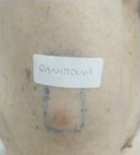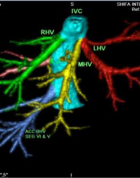Abstract
Case Report
Maculopapular delayed exanthema due to ranitidine
Pilar Hernández Alfonso*, Idoia González Mahave, Irene Vidal Oribe, Mª Dolores del Pozo Gil, Mónica Venturini Díaz and Teófilo Lobera Labairu
Published: 23 December, 2020 | Volume 4 - Issue 1 | Pages: 014-016
Ranitidine is a widely used drug in Europe and its intake is usually well tolerated. Hypersensitivity reactions due to ranitidine are uncommon. The immediate mild reactions type are the most prevalent. In some special cases a delayed type reaction such as contact dermatitis or severe reactions with systemic involvement have been reported.
In the present paper, a case report of a 78-year old patient who experienced a maculopapular eruption after 7 days of oral treatment with ranitidine is described. Patch tests were performed twice with ranitidine with positive results confirming the diagnosis. In order to discard a double sensitization and a possible cross-reactivity phenomenon, patch test was performed once with famotidine, with a negative result. This is the first maculopapular exanthema reported as type IV hypersensitivity reaction to ranitidine confirmed by patch testing.
Moreover, there are only two reported cases showing a double sensitization to ranitidine and to other H2-receptor antagonists by patch testing after a delayed reaction due to ranitidine, the other being H2-receptor antagonists involving cimetidine and nizatidine, not famotidine.
Read Full Article HTML DOI: 10.29328/journal.adr.1001012 Cite this Article Read Full Article PDF
References
- Grant SM, Langtry HD, Brogden RN. An updated review of its pharmacodynamic and pharmacokinetic properties and therapeutic use in peptic ulcer disease and other allied diseases. Drugs. 1989; 37: 801-870. PubMed: https://pubmed.ncbi.nlm.nih.gov/2667937/
- Revisión de los medicamentos que contienen ranitidina por la presencia de nitrosaminas [Internet]. Asociación Española de Mediacamentos y Productos Sanitarios. 2020. PubMed: https://www.aemps.gob.es/
- Mahase E. Ranitidine: patients taking certain batches should “immediately discontinue use,” says FDA. BMJ. 2019; l7053.
- Foti C, Cassano N, Panebianco R, Calogiuri G, Vena G. Hypersensitivity reaction to ranitidine: Description of a case and review of the literature. Immunopharmacol Immunotoxicol. 2009; 31: 414-416. PubMed: https://pubmed.ncbi.nlm.nih.gov/19694603/
- Okamoto O, Fujiwara S. Drug eruption caused by ranitidine hydrochloride (Zantac) which showed a strong reaction in a drug-induced lymphocyte stimulation test. J Dermatol. 2007; 34: 74-79. PubMed: https://pubmed.ncbi.nlm.nih.gov/17204107/
- Vérez A, Motreno JC. Second case of ranitidine related toxic epidermal necrolysis in a patient with idiopathic Thrombocytopenic purpura J Am Acad Dermatol. 2000; 42: 305. PubMed: https://pubmed.ncbi.nlm.nih.gov/10642697/
- Watts T, Haque R. DRESS Syndrome Induced by Ranitidine. The Journal of Allergy and Clinical Immunology: In Practice. 2018; 6: 1030-1031. PubMed: https://pubmed.ncbi.nlm.nih.gov/29102410/
- Palacios-Zabalza I, Camino-Rodríguez E, Aguirre C. Síndrome de Kounis inducido por ranitidina. Medicina Clínica. 2018; 151: e51-e53.
- Blanes Martínez M, Silvestre Salvador JF, Vergara Aguilera G, Betlloch Mas I, Pascual Ramirez JC. Acute generalized exanthematous pustulosis induced by ranitidine hydrochloride. Contact Dermatitis. 2003; 49-47. PubMed: https://pubmed.ncbi.nlm.nih.gov/14641127/
- Ryan PJ, Rycroft RJ, Aston IR. Allergic contact dermatitis from occupational exposure to ranitidine hydrocloride. Contact Dermatitis. 2003; 48: 67-68. PubMed: https://pubmed.ncbi.nlm.nih.gov/12694207/
- Herrera-Mozo I, Sanz-Gallen P, Martí-Amengual G. Occupational contact allergy to omeprazole and ranitidine. Medycyna Pracy. 2017; 68: 433-435. PubMed: https://pubmed.ncbi.nlm.nih.gov/28512370/
- Song W, Kim M, Lee S, Kwon Y, Kim S, et al. Two Cases of H2-Receptor Antagonist Hypersensitivity and Cross-Reactivity. Allergy, Asthma and Immunology Research. 2011; 3: 128-131. PubMed: https://www.ncbi.nlm.nih.gov/pmc/articles/PMC3062792/
- Morisset M, Moneret-Vautrin DA, Loppinet V, Grandidier S. Cross-allergy to ranitidine and nizatidine. Allergy. 2000; 55: 682-683. PubMed: https://pubmed.ncbi.nlm.nih.gov/10921476/
- Bocșan IC, Sabin O, Matei D, Muntean A, Buzoianu AD. How often we diagnose allergy to ranitidine? Eur Rev Med Pharmacol Sci. 2020; 24: 10812-10818. PubMed: https://pubmed.ncbi.nlm.nih.gov/33155242/
- Dwivedi S, Chopra D, Arora P, Khan S. Anaphylaxis following intravenous ranitidine: A rare adverse reaction of a common drug. Indian J Pharmacol. 2014; 46: 234-236. PubMed: https://pubmed.ncbi.nlm.nih.gov/24741203/
- Mori F, Barni S, Pecorari L, Sarti L, Pucci N, et al. Anaphylaxis to Intravenous Ranitidine in a Child. Pharmacology. 2015; 95: 240-242. PubMed: https://pubmed.ncbi.nlm.nih.gov/25967233/
- Yilmaz I, Turk M. Ranitidine-Induced Anaphylaxis in a Patient with Acute COPD Exacerbation. Turk Thorac J. 2017; 18: 94-95. PubMed: https://pubmed.ncbi.nlm.nih.gov/29404169/
- Bossi A, Romeo G, Pezzoli A. Side-effects, structure, and H2-receptor antagonists. Lancet. 1992; 339: 1366.PubMed: https://pubmed.ncbi.nlm.nih.gov/1350041/
Figures:

Figure 1
Similar Articles
-
Clinical significance of Vibration Anesthesia on reducing pain of Ring-Block (Subcutaneous Injections) in the patients undergoing Hair Restoration SurgeryMuhammad Ahmad*,Mohammad Humayun Mohmand. Clinical significance of Vibration Anesthesia on reducing pain of Ring-Block (Subcutaneous Injections) in the patients undergoing Hair Restoration Surgery. . 2017 doi: 10.29328/journal.adr.1001001; 1: 001-005
-
Lifestyle Diseases and the Hair Growth Cycle: A multidisciplinary approach using Nourkrin® with Marilex®, a proteoglycan replacement therapy, for anagen induction and maintenanceThom E*,Thom EW. Lifestyle Diseases and the Hair Growth Cycle: A multidisciplinary approach using Nourkrin® with Marilex®, a proteoglycan replacement therapy, for anagen induction and maintenance. . 2017 doi: 10.29328/journal.adr.1001002; 1: 006-011
-
It is not invisible! A case report of 2 patients with scalp Lichen Planopilaris mimicking Androgenic AlopeciaFabio Rinaldi*,Sorbellini Elisabetta,Pinto Daniela,Marzani Barbara. It is not invisible! A case report of 2 patients with scalp Lichen Planopilaris mimicking Androgenic Alopecia. . 2017 doi: 10.29328/journal.adr.1001003; 1: 012-017
-
Metabolic Syndrome, Cardiovascular Disease and the Hair Growth Cycle: Addressing hair growth disruptions using Nourkrin® with Marilex® as a proteoglycan replacement therapy: A concise reviewThom E*,Wadstein J,Kingsley DH*,Thom EW . Metabolic Syndrome, Cardiovascular Disease and the Hair Growth Cycle: Addressing hair growth disruptions using Nourkrin® with Marilex® as a proteoglycan replacement therapy: A concise review. . 2018 doi: 10.29328/journal.adr.1001004; 2: 001-007
-
Linear IgA bullous dermatosis in a child successfully responding to oral antibioticsG Senhaji*,H Bay Bay,O El Jouari,A Lamouaffaq,Z Douhi,S Elloudi,FZ Mernissi ,R Dassouli. Linear IgA bullous dermatosis in a child successfully responding to oral antibiotics . . 2018 doi: 10.29328/journal.adr.1001005; 2: 008-011
-
Daub, Discolouration, Pigmentation-Solar LentigoAnubha Bajaj*. Daub, Discolouration, Pigmentation-Solar Lentigo. . 2019 doi: 10.29328/journal.adr.1001006; 3: 001-006
-
We may need to reconsider when to apply sunscreen in our daily lifeWin L Chiou*. We may need to reconsider when to apply sunscreen in our daily life. . 2019 doi: 10.29328/journal.adr.1001007; 3: 007-010
-
Evaluation in real life of the impact of photo-protection counseling in patients with actinic keratosisCharles Taïeb*,Khaled Ezzedine,Sophie Seité. Evaluation in real life of the impact of photo-protection counseling in patients with actinic keratosis. . 2019 doi: 10.29328/journal.adr.1001008; 3: 011-012
-
Leprosy persistence in the health district of Kenieba despite its elimination as a public health problem at the national level in MaliIlo Dicko*,Yaya Ibrahim Coulibaly,Modibo Keita,Housseini Dolo,Modibo Sangaré,Abdoulaye Fomba,Mamoudou Kodio,Nouhou Diarra,Mamadou Sidibé,Oumar Maiga,Moussa Brema Sangaré,Siaka Yamoussa Coulibaly,Michel Emmanuel Coulibaly,Mamadou Dolo,Sory Ibrahima Fomba,Abdallah Amadou Diallo,Floribert Fossuo Thotchum,Ousmane Faye,Samba Ousmane Sow. Leprosy persistence in the health district of Kenieba despite its elimination as a public health problem at the national level in Mali . . 2020 doi: 10.29328/journal.adr.1001009; 4: 001-005
-
Bee venom: a case of effectiveness on skin varicosities veins with review of its dermatological benefitsMohamed El Amraoui*,Rachid Frikh,Naoufal Hjira,Mohammed Boui. Bee venom: a case of effectiveness on skin varicosities veins with review of its dermatological benefits. . 2020 doi: 10.29328/journal.adr.1001010; 4: 006-008
Recently Viewed
-
Detrimental Effects of Methylenetetrahydrofolate Reductase (MTHFR) Gene Polymorphism on Human Reproductive Health: A ReviewVandana Rai*,Pradeep Kumar. Detrimental Effects of Methylenetetrahydrofolate Reductase (MTHFR) Gene Polymorphism on Human Reproductive Health: A Review. Clin J Obstet Gynecol. 2025: doi: 10.29328/journal.cjog.1001182; 8: 007-014
-
Fetal Bradycardia Caused by Maternal Hypothermia: A Case ReportMuna Alqralleh,Rahma Al-Omari,Shrouq Aldahabi,Doha Abdelbage,Maher Al-Hajjaj*,Lujain Alababesh. Fetal Bradycardia Caused by Maternal Hypothermia: A Case Report. Clin J Obstet Gynecol. 2025: doi: 10.29328/journal.cjog.1001180; 8: 001-002
-
Betty Neuman System Model: A Concept AnalysisAdnan Yaqoob*, Rafat Jan, Salma Rattani and Santosh Kumar. Betty Neuman System Model: A Concept Analysis. Insights Depress Anxiety. 2023: doi: 10.29328/journal.ida.1001036; 7: 011-015
-
Rare Locations of Plasma Cell Tumour: A Single-Centre ExperienceVladimir Prandjev,Donika Vezirska,Ivan Kindekov*. Rare Locations of Plasma Cell Tumour: A Single-Centre Experience. J Hematol Clin Res. 2025: doi: 10.29328/journal.jhcr.1001036; 9: 015-019
-
Developmentally appropriate practices on knowledge skills for contributing child’s intelligences of receptive language skills in appropriate and inappropriate early childhoodsNarida Rattana-Umpa,Jirawon Tanwatthanakul*,Churaporn Sota,Toansakul Tony Santiboon. Developmentally appropriate practices on knowledge skills for contributing child’s intelligences of receptive language skills in appropriate and inappropriate early childhoods. Arch Psychiatr Ment Health. 2021: doi: 10.29328/journal.apmh.1001034; 5: 042-050
Most Viewed
-
Feasibility study of magnetic sensing for detecting single-neuron action potentialsDenis Tonini,Kai Wu,Renata Saha,Jian-Ping Wang*. Feasibility study of magnetic sensing for detecting single-neuron action potentials. Ann Biomed Sci Eng. 2022 doi: 10.29328/journal.abse.1001018; 6: 019-029
-
Evaluation of In vitro and Ex vivo Models for Studying the Effectiveness of Vaginal Drug Systems in Controlling Microbe Infections: A Systematic ReviewMohammad Hossein Karami*, Majid Abdouss*, Mandana Karami. Evaluation of In vitro and Ex vivo Models for Studying the Effectiveness of Vaginal Drug Systems in Controlling Microbe Infections: A Systematic Review. Clin J Obstet Gynecol. 2023 doi: 10.29328/journal.cjog.1001151; 6: 201-215
-
Causal Link between Human Blood Metabolites and Asthma: An Investigation Using Mendelian RandomizationYong-Qing Zhu, Xiao-Yan Meng, Jing-Hua Yang*. Causal Link between Human Blood Metabolites and Asthma: An Investigation Using Mendelian Randomization. Arch Asthma Allergy Immunol. 2023 doi: 10.29328/journal.aaai.1001032; 7: 012-022
-
Impact of Latex Sensitization on Asthma and Rhinitis Progression: A Study at Abidjan-Cocody University Hospital - Côte d’Ivoire (Progression of Asthma and Rhinitis related to Latex Sensitization)Dasse Sery Romuald*, KL Siransy, N Koffi, RO Yeboah, EK Nguessan, HA Adou, VP Goran-Kouacou, AU Assi, JY Seri, S Moussa, D Oura, CL Memel, H Koya, E Atoukoula. Impact of Latex Sensitization on Asthma and Rhinitis Progression: A Study at Abidjan-Cocody University Hospital - Côte d’Ivoire (Progression of Asthma and Rhinitis related to Latex Sensitization). Arch Asthma Allergy Immunol. 2024 doi: 10.29328/journal.aaai.1001035; 8: 007-012
-
An algorithm to safely manage oral food challenge in an office-based setting for children with multiple food allergiesNathalie Cottel,Aïcha Dieme,Véronique Orcel,Yannick Chantran,Mélisande Bourgoin-Heck,Jocelyne Just. An algorithm to safely manage oral food challenge in an office-based setting for children with multiple food allergies. Arch Asthma Allergy Immunol. 2021 doi: 10.29328/journal.aaai.1001027; 5: 030-037

If you are already a member of our network and need to keep track of any developments regarding a question you have already submitted, click "take me to my Query."
















































































































































